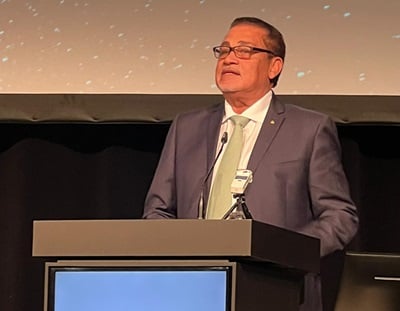NAIROBI, Kenya (eTN) – Kenya’s beleaguered tourism industry has begun the process of laying strategies to claim its position as Eastern Africa’ s leading tourism nation.
Despite welcoming record 2 million tourists last year, the country has seen its tourism fortunes dwindle as worried tourists fled the country after violence broke out following a disputed Presidential election held on December 27 last year.
The Kenya Tourist Board managing director Ongong’a Achieng expects the first quarter of 2008 to record an average of 9,000 arrivals per month, thus generating a total of 27,000 which translates into a record heavy decline of 91.4 percent compared to the same period of 2007.
“As we embark on the colossal task of regaining the lost ground and rebuilding the destination image, we will be looking up to the media, industry, Government and development partners to support us even more than ever before,” Achieng said.
Still, several thousand tourists are in the country, shrugging off fears over their safety after discovering that all tourist resorts were never even threatened after all.
Nairobi hotels, the wildlife parks and reserves and the beach resorts at the coast have not experienced any problems at all throughout the whole period of this post-election crisis.
“Here on the ground in Nairobi, on safari and at the coastal beach resorts, the situation is very different from what is being shown on TV,” Jake Grieves-Cook, the managing director of Gamewatchers Safaris, one of the leading tour operators in East Africa, says in a newsletter to his clients and the industry at large.
All the international airports in Nairobi and Mombasa have been open and functioning as normal throughout, with daily international flights operating. The highways between the airports and the international hotels have all been open as usual and literally thousands of tourists in hundreds of vehicles have been driven along these routes daily without any problem.
“All of us at Gamewatchers Safaris and in our four Porini Camps have been able to carry on with our lives as normal, welcoming our clients on safari as usual and receiving positive comments from all our guests who have been here in the last few weeks,” Grieves-Cook said.
Most of the sporadic violence, confined largely to the Rift Valley and Western Kenya, eased three weeks ago. What the international media has not properly explained is that the sporadic violence that started after the disputed election has been very largely confined to the western corner of Kenya in the areas around Kisumu, Kericho and Eldoret and in the slums and high-density housing estates outside Nairobi, which are places where tourists do not normally go.
Political leaders and wananchi (ordinary Kenyans) are awaiting the results of ongoing mediation talks spear headed by former UN Secretary General, HE Koffi Anan.
Both the government and the opposition have called on their supporters to shun violence and to restore peace so we hope that soon we will start seeing an end to the violence.
The scenes which have been shown on international TV (and some of the same scenes from four weeks ago have been shown over again as if they are still happening) were filmed by international TV crews in western Kenya or in the slums but the impression is given that this is the scene throughout the country, which is just not true.
“What has been happening in the areas around Kisumu, Kericho and Eldoret is absolutely tragic for this country and Kenyans from all levels of society have been calling for peace and an end to violence in the affected areas,” observed Grieves-Cook.
The Kenya Tourist Board (KTB) expects an industry loss of Ksh5.5 billion (US$100 million) on the average per month in the first quarter. The decline in revenue at the end of the quarter is estimated at 78.1 percent.
KTB industry analysis shows two scenarios for recovery–If a political solution is found quickly and the government maintains its current expenditure pattern for tourism marketing, the sector will recover in 2009, and, with a political solution and government intervention through increased expenditure of up to Ksh1.5 billion (US$21.5 million) for recovery, the sector may experience faster recovery around October. However, this requires that the expenditure be available by the end of this quarter.
The way forward
Since the onset of the post-election skirmishes, the tourism crisis management committee has been working tirelessly to provide accurate daily updates on the situation to travel trade and media in the source markets as well as working with local and foreign media to counter negative publicity in the global media.
The recovery campaign for Kenya’s tourism will be implemented in two phases, according to KTB managing director Achieng. The first phase will involve re-building the image of the destination and building confidence in the consumer through PR. The positive side to this campaign is that we have goodwill and support of all airlines flying into and within the destination, hoteliers and tour operators, as well as suppliers and travel trade media in source markets.
Under the first phase, KTB work with local media to generate positive publicity on the destination and also bring in big numbers of journalists from traditional and new markets like China, India, Japan and Eastern Europe to experience the destination first hand and report to their audience back home on the situation, thus building destination confidence in the consumer and trade.
This will be followed by targeted visits by industry and government delegations to suppliers, media and consumers in source markets to instill confidence. We also intend to bring in celebrities from the source markets to get wider endorsements and help polish our image.
The second phase of the recovery is part of a wider marketing campaign with full participation of the industry. “We expect it to include incentives from industry, government and partnership with tour operators abroad,” Achieng said.
WHAT TO TAKE AWAY FROM THIS ARTICLE:
- “Here on the ground in Nairobi, on safari and at the coastal beach resorts, the situation is very different from what is being shown on TV,” Jake Grieves-Cook, the managing director of Gamewatchers Safaris, one of the leading tour operators in East Africa, says in a newsletter to his clients and the industry at large.
- The scenes which have been shown on international TV (and some of the same scenes from four weeks ago have been shown over again as if they are still happening) were filmed by international TV crews in western Kenya or in the slums but the impression is given that this is the scene throughout the country, which is just not true.
- What the international media has not properly explained is that the sporadic violence that started after the disputed election has been very largely confined to the western corner of Kenya in the areas around Kisumu, Kericho and Eldoret and in the slums and high-density housing estates outside Nairobi, which are places where tourists do not normally go.






















